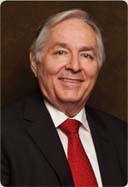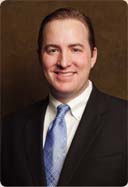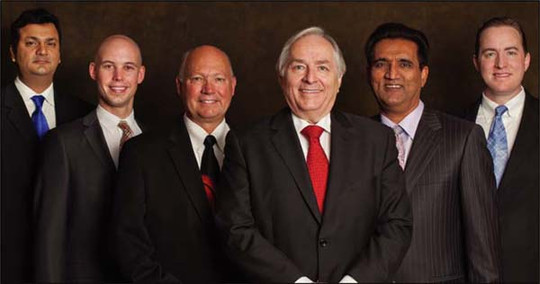
James L. Holly, M.D.
A dozen years before the term meaningful use entered the healthcare lexicon in relation to electronic health records, Southeast Texas Medical Associates (SETMA), a Beaumont-based 22-physician multi-specialty medical group, acquired its electronic health record (EHR) system. It was the organization's first baby step in an ongoing journey that has led its physicians to embrace the intensive use of outcome measures as an integral part of providing care to their patients. In a rapid succession of innovations, SETMA has essentially exploded the traditional black box of clinical care by introducing the concepts of audits, performance tracking, and-not least-public reporting of physician performance, as a way to drive constant improvement in the quality of patient care.
IT WAS A TRANSFORMATIVE THING, A EUREKA MOMENT, BECAUSE WE SUDDENLY REALIZED WE COULD DO THINGS THAT OTHERWISE COULD NOT BE DONE.-JAMES L. HOLLY, M.D.
That goal was the vision of James L. Holly, M.D., CEO and one of four founding partners of SETMA. In 1997, Holly and a colleague attended a strategic planning session at a meeting of the Denver-based Medical Group Management Association. Following the session, the two compared notes, and discovered they both had the same objective: to lead, guide, and direct healthcare in Southeast Texas through excellence. That, says Holly, planted the seed of the organization's strategy.
In March 1998, three years after SETMA opened the doors of its practice, the group acquired its EHR system from the Horsham, Pa.-based NextGen Healthcare Information Systems. By the following January, all of the patients in the clinic were on the system.
But the partners wanted more than an electronic method of documenting patient visits. Holly realized that the system could be used to gain treatment leverage. He envisioned that SETMA's EHR system would eventually provide the organization with a way to audit, analyze, and compare what its providers were doing and share that information electronically across its network. “It was a transformative thing, a Eureka moment, because we suddenly realized we could do things that otherwise could not be done,” he says.
To that end, SETMA set about customizing the EHR system with a set of disease management tools, in the form of electronic templates that would allow its physicians to gain treatment leverage with their patients. Holly estimates that it took about a year for SETMA to devise its first set of templates to track various disease groups, which were, and continue to be, developed in-house.
SETMA has developed a series of templates in major disease areas, including hypertension, lipids, diabetes, asthma, and weight management, explains Jonathan Owens, the clinical systems engineer at SETMA who designed the electronic tools. In addition, SETMA has designed sets of templates for various practice specialties, such as physiotherapy, pediatrics, and rheumatology, as well as specific templates geared to nursing home care.
Each template contains itemized measures on specific health conditions, such as care for diabetic patients. If the text is gray, it doesn't apply to the patient; if it is black, it does apply, and the physician's care is in compliance with desired parameters; and if it is red, one or more measures are out of compliance.
Using its customized EHR as a foundation, SETMA has moved rapidly on refining its vision, divided into two major initiatives: the Patient Centered Medical Home; and real-time data access, auditing and reporting, which can broadly be defined as SETMA's Model of Care.
Holly believes that, ultimately, three things can transform healthcare for the better: an IT foundation; an evidence-based foundation for the IT; and a performance-based payment structure that offers some possibility of recovery for improved care or the decreased cost of care.
In his view, reliance on quality metrics is the key to improving patient outcomes. SETMA employs a “cluster” of seven or more quality metrics for a single condition; “galaxies,” or multiple clusters of conditions, are tracked for patients with multiple health conditions. Holly maintains that the group has achieved significant results.
Among the gains made within the organization has been a significant reduction in unnecessary variations in care. Between 2000 and 2010 SETMA has shown an annual improvement in the mean and the median results for the treatment of diabetes, logging an improvement each year. From 2008 to 2009, SETMA experienced a 9.3 percent improvement in standard deviation; and some individual SETMA providers had an improvement of more than 16 percent in their standard deviations.
FOCUS ON QUALITY CARE
In 2009 Holly attended a workshop on the Patient-Centered Medical Home (PCMH), a recognition program of the National Committee for Quality Assurance (NCQA). PCMH recognition, he believed, was the best way to demonstrate his group's commitment to quality improvement for both patients and payers. Maintaining it would require reliance on patient-care data to change provider and patient behavior, modify practice procedures, and improve patient health by focusing on preventative care.

Richmond Holly
“We've been trying to develop the tools that we need to provide care to our patients,” explains Richard Bryant, chief operating officer of SETMA. That includes “feedback we give to our providers on how they are performing on each segment of their [patient] population.”

Jonathan Owens
At SETMA, the centerpiece of the PCMH is coordination of care-a team approach that provides support to the physician as well as ensures that patients understand that they are an active participant in their own healthcare. As noted by Holly, to be a patient-centered organization, it's crucial that patients buy into what the providers are selling.
“There are 8,760 hours in a year. If a patient is in the doctor's office a lot, it's 10 hours a year; for the rest, they are in charge of their own care,” he says. “We have got to make sure that the patient is engaged, empowered, and enabled to fulfill their responsibility,” Holly says. The mandate under PCMH has given the group the vision for doing that, he says.
SETMA's coordination of care is a combination of provider teams and the use of electronic disease management templates, to make sure that no patient falls through the cracks during his treatment, whether at the clinic, in the hospital, or at home.
Bryant explains that during a patient's treatment, a three-person coordination of care team is charged with making sure that patients have everything they need, based on electronic audits of their treatment in the clinic or hospital.
For example: when a patient comes into the clinic, the provider fills out a template that addresses each one of his health issues. The template is forwarded to a referrals department that schedules the required tests. If the patient requires multiple interventions, the coordination of care team gets involved, to schedule as many tests as possible in a single day-an especially important consideration for patients who are working, Bryant says.
If a patient needs hospitalization, a set of templates is filled out regarding orders for the hospital team. By the time the patient arrives, the orders have already been transmitted, and SETMA's nurse practitioner is on hand to see the patient. When the patient is transferred home, SETMA informs its home health nurses that the patient has been discharged, to make sure he has everything he needs.
When the patient is sent home, the coordination of care team is alerted, and one of the three team members contacts the patient in a follow-up phone call that averages between 12 and 30 minutes. Team members “have a protocol of what they have to ask and they report back to the provider,” Holly explains.
BY THE NUMBERS
SETMA took 19 months to achieve PCMH recognition, from February 2009 to September 2010. As part of that effort, the group performed an internal analysis of its operations. It realized that PCMH recognition hinged on its ability to audit provider performance and patient information in real time and against national quality standards.
This decision led to the group's next investment: business intelligence software that would enable the group to perform auditing and analysis. “During the first years, with NextGen, we were focused on documenting, gathering, and retention. Now it was time to start mining the data, to use it to make business and clinical decisions,” explains Richmond Holly, chief information officer of SETMA.
As tracking under the EHR system gained momentum, the demand for reports increased substantially, he says. “That was challenging, because, for just one of the initiatives, NCQA, there were about 100 or 120 reports, and they wanted them daily, for SETMA as a whole, each location, and each doctor individually,” he says. “That was when we realized we needed to automate it.”
After conducting a search, the group settled on COGNOS, a business intelligence software package supplied by IBM Corp. COGNOS has allowed SETMA to do auditing and analysis, setting the stage for constant improvement.
Using COGNOS' auditing capabilities, SETMA is able to examine care patterns over patient populations, by provider, practice, or the entire clinic. It has given the group the ability to show seasonal patterns of care, and to compare one provider with another. For example, patients can be compared by socio-economic conditions and ethnicity, offering ways to modify care to ensure that all patients meet their health goals. In addition, COGNOS makes it possible to statistically analyze performance audits, to measure improvement by practice, clinic, or provider.
Using COGNOS, SETMA is able to publicly report the performance of each provider on hundreds of quality measures. The information is available to the providers in the group, as well as to the public. Holly says the idea of public reporting is a useful tool to put pressure on all of the providers to improve their performance.
Owens cites one practical example of COGNOS has paid off in improved patient quality: SETMA has created dashboards for three major health conditions, including diabetes, hypertension, and lipids.
For diabetes, the dashboard looks at hemoglobin A1C values for diabetics and then takes an average of the values for all patients, which are considered uncontrolled. Both groups of patients showed a spike in A1C values every year around the holidays. This year SETMA sent a letter to all of its diabetic patients, noting that it's the holidays and reminding them that many diabetics lose control due to eating and lack of exercise. The letter included a card for patients to fill out before their next visit, in which they pledged to be more active and to keep their appointments. The next step was to build a more extensive dashboard for each of the diabetic conditions.
IT TAKES A TEAM
SETMA provides training for its providers in using the tracking and auditing tools. “We make sure that everybody has the same information on how to use the systems,” Holly says. “One of the principles of building an IT system is that we wanted to make it easy to do it right, or not do it at all. We've achieved that. The buy-in is that people are really pleased, because they see the benefits.”
Muhammad Aziz, M.D., is a managing partner and practicing physician at SETMA. Speaking as a physician, he says that SETMA's installed IT infrastructure is central to making the PCMH concept possible in actual practice. “The concept of Medical Home is that you make the patient part of his care,” he says. “The problem is that to do so, the patient requires a lot of different types of knowledge. If the patient does not understand what to do, he will not follow through,” he says.
In his experience at another hospital during the 1990s, attempts to employ the PCMH concept failed. “It was not fruitful or effective, because the time for treating patients was not there. It was cumbersome, and it takes a lot of time to teach a patient about diabetes,” he says.
SETMA has overcome that barrier by taking a team approach, making specialists available to teach the patient about various aspects of the disease. For example, a certified dietitian on staff gets diet information to the patient in a short period of time.

SETMA's Model of Care is a team effort. Pictured from left to right are: Syed Imtiaz Anwar, M.D., partner; Jonathan Owens, clinical systems engineer; Richard Bryant, chief operating officer; James L. Holly, CEO; Muhammad Aziz, M.D., managing partner; and Richmond E. Holly, CIO
Aziz notes that the immediacy of the available information that is available with the templates would have been unthinkable a decade ago. At SETMA, he says, a click of the button can generate a list of preventative measures required by a particular patient. By pressing pre-visit evaluation, a screen will display preventative measures for individual patients according to age, sex, or disease.
THE CONCEPT OF MEDICAL HOME IS THAT YOU MAKE THE PATIENT PART OF HIS CARE.-MUHAMMAD AZIZ, M.D.
Following a visit, a patient receives a print-out of a personalized follow-up plan, with his or her name on it. For patients with multiple referrals, the care coordination team arranges visits with various specialists in a single day. Following a hospital visit, the results of the follow-up call are fed into the physician's workflow. If a prescription was not ordered, it will be called in the next day.
Syed Imtiaz Anwar, M.D., a senior partner who has been at SETMA since 1997, points to quantifiable improvements in patient care. For diabetics, glycohemoglobin blood sucrose tests have gone from 8.1 in 2001 to 6.8 today. In hypertension, SETMA has reduced smoking among its patients by 20 percent.
SETMA has also significantly decreased the population of its patients in hospitals. “Eight to 10 years ago we carried maybe 80 patients in the hospital. Since then we have doubled our number of practice, to close to 73,000 patients, including over 600 nursing home patients, but our average census in the hospital is now 45 to 50 patients,” he says. Anwar attributes the lower numbers of hospitalized patients to better follow-up. SETMA's hospital readmission rates have dropped from 12 percent to 2 percent, he says.
SPREADING THE WORD
In December, SETMA became an affiliate of the Boston-based Diabetes Center of Excellence. Holly had first contacted the Joslin Center in 2003. “For seven years we corresponded and talked, and that's what brought us to being the first primary-care multi-specialist group affiliate,” Holly says.
Holly also notes that SETMA has begun to reach out to local providers in his geographic area through a health information exchange. “Our goal over next five years is to have every provider and every organization in a five-city area connected so that they can share data. And they can share data even if it is not with us. Share with one another, so that everyone connected. That's our gift to the community.”
Healthcare Informatics 2011 February;28(2):16-20 |